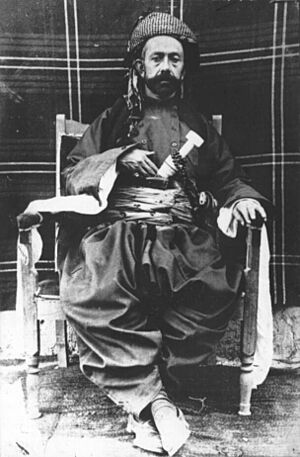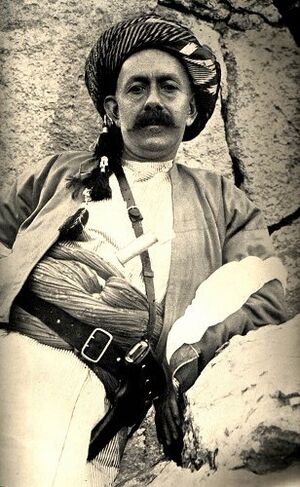Mahmud Barzanji facts for kids
Quick facts for kids SheikhMahmoud Barzanji شێخ مهحموود |
|
|---|---|
| Şêx Mehmûdê Berzencî Sheikh Mahmud Barzanji |
|
 |
|
| King of Kurdistan | |
| Reign | 1922–1924 |
| Predecessor | British Empire |
| Successor | Position abolished (Faisal I of Iraq as King of Iraq) |
| Born | 1878 Sulaymaniyah, Mosul Vilayet, Ottoman Iraq, Ottoman Empire |
| Died | 9 October 1956 (aged 77–78) Baghdad, Iraq |
| Burial | Sulaymaniyah, Iraqi Kurdistan, Iraq |
| Issue | Baba Ali Shaikh Mahmood (son, 1912–1996) |
Sheikh Mahmud Barzanji (Kurdish: شێخ مهحموود بەرزنجی) was an important Kurdish leader. He lived from 1878 to 1956. Sheikh Mahmud led several uprisings against the British Mandate in Iraq. He was a religious leader, a sheikh, from the Barzanji clan in Sulaymaniyah. This city is now part of Iraqi Kurdistan. During his revolts, he was even called the King of Kurdistan.
Contents
Why did Sheikh Mahmud become a leader?
After World War I, the British and other European powers took control of parts of the Ottoman Empire. The British planned to rule the area that is now Iraq. They wanted to control the cities of Baghdad and Basra. These areas were mostly home to Arab people.
In 1921, the British chose Faisal I to be the King of Iraq. This was an interesting choice because Faisal was not from Iraq. He was from a royal family in Western Arabia.
The Kurdish Region and British Promises
At the same time, the British were also making plans for northern Iraq. This area was mainly home to Kurdish people. It was known as Greater Kurdistan. The British drew new borders. These borders placed the Kurds between central Iraq and the former Ottoman lands.
The Kurdish people lived in the mountains of the Mosul Vilayet. This region was hard for the British to control. The British had promised the Kurds their own land during World War I. They said the Kurds could form their own state. But after the war, the British did not keep this promise. This made the Kurds very upset.
The British wanted to set up a Kurdish protectorate. This meant they would protect the area but still control it. So, they appointed Sheikh Mahmud as governor of southern Kurdistan. He was a popular leader in the region.
Sheikh Mahmud's Rise to Power
Sheikh Mahmud was a very ambitious leader. He wanted the Kurds to have their own independent state. The British first made him governor of Sulaimaniah. They thought this would help them rule the region indirectly. They believed Mahmud would help keep the area calm.
But Sheikh Mahmud had bigger plans. He wanted more power for himself and for the Kurdish people. He was declared "King of Kurdistan." He claimed to rule all Kurds. However, not all Kurds agreed with him. Some thought he was becoming too powerful.
Uprisings Against British Rule
At first, the British allowed Mahmud to follow his goals. They thought he was helping them control the region. But by 1920, Mahmud started using his power against the British. He arrested British officials in the Kurdish region. He also began leading uprisings.
His first rebellion lasted until he was hurt in a fight. British forces captured him. He was sentenced to death, but his sentence was changed. He was sent to prison in Lahore, India. Mahmud stayed in India until 1922.
Sheikh Mahmud's Return and Second Revolt
While Sheikh Mahmud was in India, Turkish nationalists were causing trouble. These Turkish groups were led by Mustafa Kemal Atatürk. They wanted to take back Mosul in northern Iraq. The British were finding it hard to control northern Iraq without Sheikh Mahmud.
British officials debated whether to bring Sheikh Mahmud back. They hoped he could bring peace to the region. Sir Percy Cox, a British administrator, argued for his return. Cox believed Mahmud was the only hope for stability. He knew there were risks, but the Kurds were growing restless. They felt the British were breaking their promises of self-rule.
Becoming King of Kurdistan Again
Cox decided to bring Sheikh Mahmud back. He named him governor of southern Kurdistan again. On December 20, 1922, Cox also agreed to a plan. This plan would allow a Kurdish government if they could create a constitution.
When Mahmud returned, he declared himself King of the Kingdom of Kurdistan. He rejected the deal with the British. Instead, he started working with the Turks against the British. Cox realized his mistake. In 1923, he took back his offer of an independent Kurdish state.
Sheikh Mahmud remained king until 1924. He continued to lead uprisings against the British until 1932. Finally, the Royal Air Force and British-trained Iraqi forces captured him again. He was then sent away to southern Iraq.
Later Life and Legacy
Sheikh Mahmud asked for peace and was exiled in southern Iraq in May 1932. He was allowed to return to his family village in 1941. He lived there for the rest of his life. He passed away in 1956 with his family.
Today, Sheikh Mahmud is still remembered as a hero. There are displays of him in Iraqi Kurdistan, especially in Sulaimaniah. He is seen as a pioneer for Kurdish nationalism. He fought for the independence and respect of his people. Many future Kurdish leaders look up to him.
See also
- Kingdom of Kurdistan
- RAF Iraq Command



